How to change a bearing on a Samsung washing machine
 A Samsung washing machine of any model is of good quality and has a long service life. No matter how good a car is, there comes a time when it begins to demand attention. In particular, bearings often break in such a machine. It would seem like a “no-brainer”, it costs a penny and it’s easy to replace. But that’s not the case, you still need to get to this bearing correctly, and then remove it correctly without damaging anything. Now that’s a challenge!
A Samsung washing machine of any model is of good quality and has a long service life. No matter how good a car is, there comes a time when it begins to demand attention. In particular, bearings often break in such a machine. It would seem like a “no-brainer”, it costs a penny and it’s easy to replace. But that’s not the case, you still need to get to this bearing correctly, and then remove it correctly without damaging anything. Now that’s a challenge!
What do we need for repairs?
Bearings in a Samsung washing machine are not repaired, but replaced, therefore, first of all, we should take care of purchasing the necessary components. Currently on the market you can find a bearing repair kit specifically for Samsung washing machines. There in one package they immediately contain:
- bearings;
- oil seals;
- special lubricant.
There is really one catch, Repair kits are produced for different models of washing machines, so in order not to accidentally confuse anything, you need to know which bearings are suitable for which models of washing machines. To avoid mistakes, experts have prepared a table of components for a Samsung washing machine. After familiarizing yourself with it, you can accurately purchase original bearings and begin work on replacing them.
In addition to components, you also need tools. To dismantle the fasteners, unwind the tank, and knock out the bearings, we will need:
- copper hammer;

- special lubricant for washing machine elements or WD-40 liquid;
- curved hex key;
- marker;
- steel pin or metal tube;
- round nose pliers or pliers;
- small adjustable wrench;
- wrenches (open-end and socket);
- indicator screwdriver, Phillips and flat;
- any sealant.
We take out the tank
We found the tools, purchased the components, you can prepare a place for convenient work, and then start disassembling the Samsung washing machine with your own hands. At the second stage, our task is to remove all the “extra” from the washing machine so that it does not interfere with dismantling the tank. This must be done in such a way that nothing breaks or gets lost, so put all the removed parts in separate piles. So, let's start disassembling.
First, remove the top wall (cover) from the machine. To do this, you need to unscrew the two fasteners that hold this cover. They are located at the top of the back wall in the corners. Then you need to place both palms on the upper wall and pull it towards you, and then lift it up.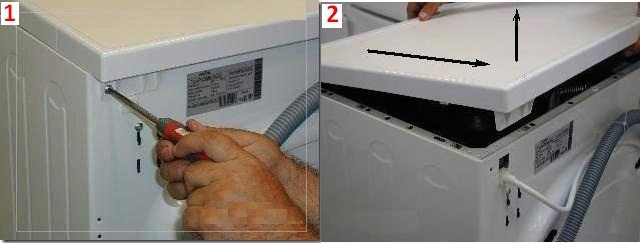
Next, take out the cuvette for the powder. This is necessary so that water does not spill out of it and flood the electronics at the moment when we tilt and turn the machine. Removing the cuvette is simple:
- you need to open it all the way;
- press the “tongue” of the central section with the finger of one hand;
- at the same time, slightly lift the cuvette with your other hand and pull it towards you;
- If everything is fine, the cuvette should pop out and remain in your hands.

Having removed the powder cuvette, unscrew the hoses supplying water to its sections, as well as the hose through which water and powder enter the tank. Remove the hoses carefully so as not to damage the clamps. Unclench the clamps using pliers, and then tighten the hoses.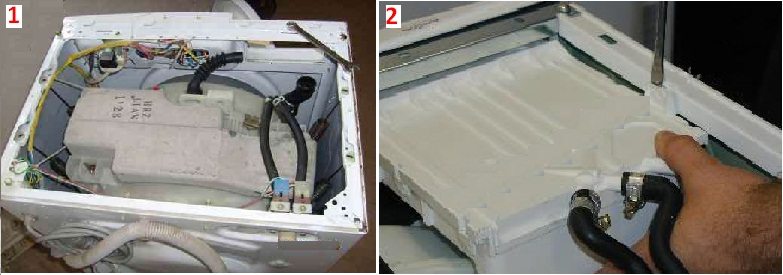
Next, our task is to remove the large upper counterweight that is bothering us. To do this, take a head of a suitable size and unscrew the two fasteners, then carefully holding the counterweight, remove it and put it aside.
Important! When unscrewing the last bolt by hand, be sure to hold the counterweight with your other hand, because it is very heavy and can slide to the side, damaging important parts of the Samsung machine.
Now let's move on to the front wall of the Samsung washing machine. We need to remove it with our own hands, but to do this we will have to properly dismantle the rubber cuff without damaging the element of the hatch locking system. What needs to be done?
- We unscrew the two fasteners of the hatch locking device.
- Then we disconnect its sensor so as not to tear off the wire when removing the cuff.
- We screw the bolts back in so as not to lose them.
- We take a screwdriver, find the steel cable of the clamp at the base of the cuff and pry it off.
- We run a screwdriver under the clamp, pulling it off the groove. Our task is to find the fastening element of the clamp in order to loosen and remove it.
- Loosen the bolt and remove the clamp from the cuff.
- We insert our fingers under the cuff of the hatch and carefully pull it towards ourselves.

You don’t have to pull the cuff all the way out, the main thing is that it doesn’t interfere with removing the front wall. Leave the front wall alone for a while. Now we need to place the Samsung washing machine on its side to remove the bottom. To do this, unscrew the four fasteners that hold the bottom cover and remove it.
Now let's get into the electrical stuff. It is necessary to disconnect all wiring from the electric motor of the Samsung washing machine, as well as from the drain pump. It would be nice to film the process of working with electricians, since it is easy to get confused in the wiring. If this is not possible, then you can simply make marks using a marker.
Note! The contacts connecting the wire to the unit sensors are quite flimsy, so try to act carefully.If a burnt wire or contact is found, it should be replaced immediately.
We proceed to dismantling the racks on which the washing machine tank rests. To do this, you need to unscrew the four fasteners that secure one end of the stand to the tank and the other to the bottom of the housing. We won’t unscrew anything else in the lower part except the engine; the drain pump won’t hurt us; we just need to disconnect the pipes from it.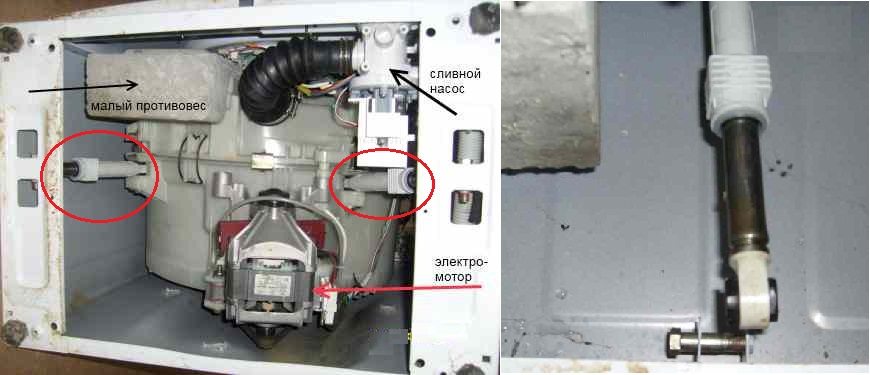
Leaving the machine on its side, we move to its upper part. Now we need to dismantle the fill valve along with the sensors and pipes. Disconnect the wire going to the valve sensors, and then unscrew the bolts holding it in place. After this, remove the valve and put it aside. We disconnect the counterweights, which are four springs on which the tank is suspended.
The path for the tank to exit through the upper part of the body is almost “cleared”; all that remains is to remove the front panel and wall. Unscrew the five screws holding the front panel and remove it. At the same time, try not to damage the control unit by tearing off the wires. Next, unscrew the front wall, unscrewing a total of 10 fasteners, and remove it to the side. In front, under the tank, we will see another small counterweight; it also needs to be unscrewed so that it does not interfere.
We have unscrewed everything that could interfere with removing the tank; now we need to very carefully pull the tank out of the body of the Samsung washing machine along with the engine. Removing the tank, drum and engine is a very important moment, you can touch some contact and then there will be more work. We turn the tank over, remove the belt from the pulley, and then use a hex key to unscrew the pulley itself.
Note! The fastening element holding the pulley can “stick”, so in order not to make unnecessary efforts, risking stripping the thread, you need to lubricate the bolt with WD-40 lubricant.
 The tank has been removed, now you can move on to the next stage of disassembly. The process of disassembling a washing machine may seem complicated to a beginner, so we recommend capturing it on video, so that later you can see what is inserted and screwed where.
The tank has been removed, now you can move on to the next stage of disassembly. The process of disassembling a washing machine may seem complicated to a beginner, so we recommend capturing it on video, so that later you can see what is inserted and screwed where.
Unscrew the tank and change the bearings
Let's start disassembling the tank of the Samsung machine and removing its drum with our own hands. We removed the stands on which the tank is located earlier by unscrewing the fasteners connecting them to the tank body. These elements are designed to hold not only the racks, but also to connect the two parts of the tank body, so we have already unscrewed the main connecting elements, all that remains is to remove the brackets and clamps. Staples and clamps can be pulled off using a screwdriver or an open-end wrench; there are no problems with them.
Remove the upper part of the tank body and expose the drum. Now remove the lower part of the housing. The result was three large elements:
- the upper part of the tank body with a hatch hole in the middle;
- the lower part of the tank body with a heating element;
- drum body with axle.
Don't just focus on bearing repairs. Check other elements of the machine along the way so that you don’t have to disassemble it again later. In particular, it would be a good idea to check the inner surface of the tank and heating element for scale. If it is there, it needs to be cleaned out immediately. The heating element must be cleaned; you can also check it with a multimeter. If there are problems heating element needs to be replaced.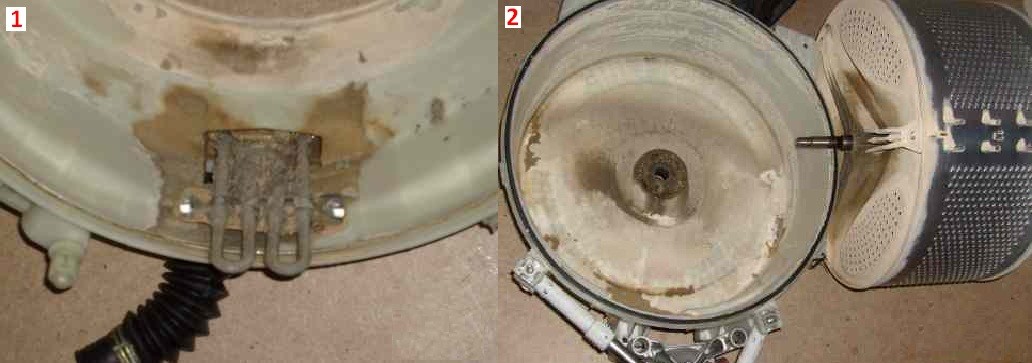
Let's start removing the bearings. The aluminum bushing of the tank body has two bearings, large and small. The large bearing should be knocked out from the outside into the tank body using a pin, the small one should be knocked out, on the contrary, from the inside of the body to the outside. We take the pin, place it against one edge of the bearing and apply a light blow with a hammer. We place the pin on the other edge and apply a light blow again, and so on in a circle until the bearing pops out.
Important! When knocking out a bearing, under no circumstances should you hit one point. Hit three or four points in turn, otherwise the bearing will go crooked and get stuck in the bushing, and this is already a problem.
 We remove the used oil seals and carefully wipe the inside of the bushing with a clean cloth. We take new oil seals, lubricate them with special grease from the repair kit and insert them into place. We take the bearings and put them in place until they rest against the shelves. You need to seat the bearings like this:
We remove the used oil seals and carefully wipe the inside of the bushing with a clean cloth. We take new oil seals, lubricate them with special grease from the repair kit and insert them into place. We take the bearings and put them in place until they rest against the shelves. You need to seat the bearings like this:
- We place the bearing in the bushing and try to seat it with our fingers as far as possible;
- take a wooden block and place it on top of the bearing;
- Apply several blows to the block with a hammer until the bearing sits in place.
That's all, the bearing replacement was successful. Now all we have to do is assemble the washing machine in reverse order. This is where the video we shot while disassembling the car or the marker marks comes in handy.
Typical "homemade" mistakes
Trying to replace the drum bearings of a Samsung washing machine yourself, “homemade” people often make mistakes, which, as a result, complicate repairs and require additional costs. What are these errors?
- Tearing off the wire that goes to the hatch blocking sensor.
- Rupture of the cuff of the washing machine hatch.
- Damage to the pulley during the process of removing it from the axle.
- Breakage of fastening bolts.
- Tearing off the wires going to the temperature sensor and heating element.
- Tearing off of pipes due to insufficiently loosening or forgetting to loosen the clamps.
- By knocking the bearings out of the drum, the bushing is broken, and it all ends with replacing the drum.
You need to be aware of these typical mistakes and never repeat them, because replacing a drum is a serious expense, and maybe even worse.
In conclusion, we note that changing the bearings that ensure the rotation of the drum of a Samsung automatic washing machine with your own hands is not easy, but it is possible. The main thing is to find out what bearings are on your model of machine, buy original components, select the necessary tools, and then, “roll up your sleeves,” do the work in accordance with the instructions of the specialists set out in this article. Happy renovation work!
Interesting:
23 reader comments
Add a comment Cancel reply
Categories
Washing machine repair


For buyers

For users

Dishwasher

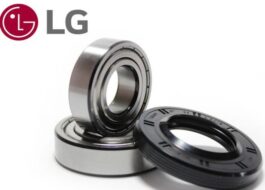
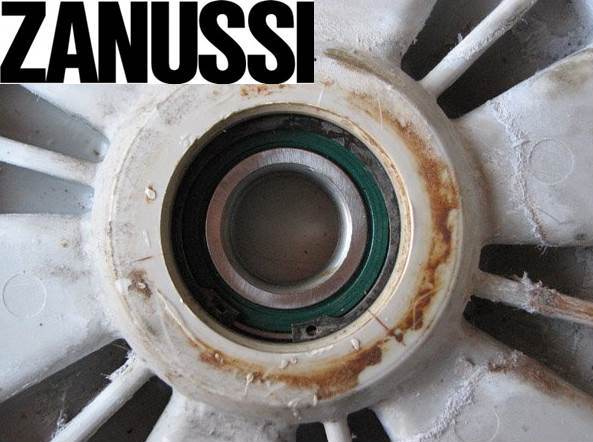

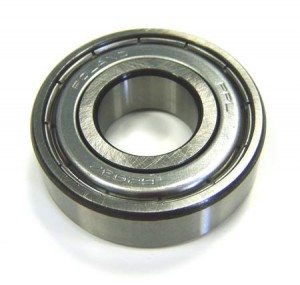

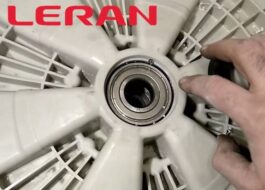










The video is very good, it helped me replace the bearings myself.
I support the previous comment. It really helps, the details are of course different, but the principle is well stated. If you know how to handle equipment and there is a store of spare parts for household appliances, you can try. The only thing you should be patient with is... The process will take a long time (I admittedly knocked out the bearings with strain), again, while you’re still removing heaps of dirt inside... But overall, I’m satisfied. A pair of bearings, a seal and grease cost $12, not bad considering the $70 alternative from a craftsman.
Tell me, did you change the drum sealing ring? Or did you put a gasket on the sealant?
The video recommends changing the gasket-ring of the tank. And it costs 2900 rubles.
Very accessible and understandable. It helped a lot. Thanks to the author of the video.
Sorry, I was misled. 2900t.r. the cuff is worth it. And they don't sell gaskets at all. I recommend that this set of tools come with ties for small bearings. Otherwise, it took about two hours to remove bearing 204 from the activator shaft using a chisel and other odds and ends. A light blow of a hammer did not release the activator. I had to use force so that the bolt was bent, but the inner bearing remained on the shaft (stuck). You need to remove it carefully so as not to damage the oil seal seat and not to break the silumin cross of the activator. I had to suffer - although I am a 6th category electrician. I have experience in removing bearings. Before pressing the bearings, lubricate the seats and shaft with grease and everything will work out easily and simply. When working, there are always unforeseen ambushes that cannot be avoided. Of course thanks for the video. Thank you! The repair cost 1000 rubles. + beer after work. Good luck master!
Hello. The large bearing does not get knocked out. What to do?
Did you manage to knock it out? Share how!
It didn't work with a hammer, a hammer drill in impact mode helped. I recommend.
Very good video! Everything worked out!
Good video. Thank you master.
Very detailed and accessible. Thank you.
The video helped, the master explained everything clearly. The ambush had a seal that was completely rotten. I had to suffer while I cleaned the seat. The bearings came out quite easily. The new ones came in without any problems. The hardest part was finding a repair kit. Service centers do not always want to sell even the simplest thing - oil seal lubricant.
If they don’t sell, it means they don’t have enough work, but with us they sell easily!
While removing the rotten oil seal, I loosened the mounting location for it. There is no way to press the new oil seal tightly; it is easily inserted and removed by hand. Is there a proven way out?
Thanks for the video. Very useful!
I have the same problem, the oil seal socket is corroded by water. The oil seal is not inserted tightly, it can be seated with epoxy or sealant, which is better? What are the options?
It is very important to clean the seat, leave the deposits behind, then it will further corrode underneath. For sealing, Kazan silicone automotive sealant, only gray! Sticks even to wet surfaces. After drying, it is almost rubber-like in rigidity. In general, a conical mandrel is made to increase the diameter of the oil seal. Hollow cone. It penetrates slightly from the inside, stretching the inner edge of the clip. It's important not to overdo it. And still on the sealant.
Hi, try sealing it with sealant.
The video helped a lot! Thank you!
Thank you for the video. Everything is very accessible and understandable.
A true professional in his field. I would trust such a master to repair anything. Thank you for the detailed repair instructions.
Everything turned out to be done by analogy, the only thing I did was entrust the pressing of the bearing to a specialist for $5.
Thank you master!